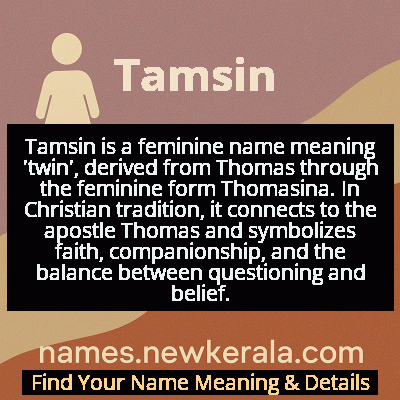Tamsin Name Meaning & Details
Origin, Popularity, Numerology Analysis & Name Meaning of Tamsin
Discover the origin, meaning, and cultural significance of the name TAMSIN. Delve into its historical roots and explore the lasting impact it has had on communities and traditions.
Name
Tamsin
Gender
Female
Origin
Christian
Lucky Number
4
Meaning of the Name - Tamsin
Tamsin is a feminine name meaning 'twin', derived from Thomas through the feminine form Thomasina. In Christian tradition, it connects to the apostle Thomas and symbolizes faith, companionship, and the balance between questioning and belief.
Tamsin - Complete Numerology Analysis
Your Numerology Number
Based on Pythagorean Numerology System
Ruling Planet
Uranus (Rahu)
Positive Nature
Strong sense of order, loyal, practical, and disciplined.
Negative Traits
Stubborn, overly serious, rigid, and prone to feeling restricted.
Lucky Colours
Blue, gray.
Lucky Days
Saturday.
Lucky Stones
Blue sapphire.
Harmony Numbers
1, 7, 8.
Best Suited Professions
Managers, engineers, accountants, organizers.
What People Like About You
Dependability, discipline, practicality.
Famous People Named Tamsin
Tamsin Greig
Actress
Award-winning British actress known for roles in 'Black Books', 'Episodes', and Royal Shakespeare Company productions
Tamsin Egerton
Actress
English actress known for roles in 'Camelot', 'Love, Rosie', and 'The Last Knights'
Tamsin Olivier
Actress and Writer
British actress and author, daughter of Sir Laurence Olivier and Joan Plowright
Tamsin Dunwoody
Politician
Welsh Labour politician who served in the Welsh Assembly Government
Name Variations & International Equivalents
Click on blue names to explore their detailed meanings. Gray names with will be available soon.
Cultural & Historical Significance
Throughout British history, the name maintained regional popularity, especially in Cornwall and southwestern England, where it became associated with local identity and heritage. The name experienced a revival during the 20th century as part of the broader trend of rediscovering traditional and regional names. In Christian contexts, the name carries the legacy of Thomas the Apostle, symbolizing both questioning faith and ultimate belief. The name's persistence across centuries demonstrates its enduring appeal and cultural resonance, particularly in regions with strong Celtic influences.
Extended Personality Analysis
Individuals named Tamsin are often perceived as intelligent, creative, and independent thinkers. They tend to possess a curious nature and analytical mind, reflecting the name's connection to Thomas the Apostle's questioning nature. Tamsins are typically known for their loyalty and deep commitment to relationships, embodying the 'twin' symbolism through their ability to form strong bonds and understand others' perspectives. Many Tamsins display a blend of traditional values and modern thinking, often showing respect for heritage while embracing contemporary ideas.
They frequently demonstrate resilience and adaptability, capable of navigating challenges with grace and determination. Their communication style tends to be thoughtful and articulate, and they often excel in fields requiring both creativity and analytical skills. The name suggests someone who is both grounded and imaginative, practical yet capable of visionary thinking. Tamsins are often seen as reliable friends and partners who value deep connections and meaningful conversations, while maintaining their individuality and independent spirit.
Modern Usage & Popularity
Tamsin remains a distinctive but not overly common choice in English-speaking countries, particularly in the United Kingdom. It experienced a moderate surge in popularity during the 1970s and 1980s as part of the trend toward traditional and regional names. Currently, it maintains steady but modest usage, often chosen by parents seeking a name that is both traditional and uncommon. The name is particularly popular in Cornwall and southwestern England, where it maintains strong cultural connections. In recent years, it has seen some international usage, especially in countries with British cultural ties like Australia and New Zealand. The various spellings (Tamsin, Tamsyn, Tamzin) allow for personalization while maintaining the name's essential character. While not ranking in the top names nationally, it continues to be appreciated for its distinctive sound and rich heritage.
Symbolic & Spiritual Meanings
The name Tamsin carries rich symbolic meaning rooted in its etymology and cultural history. Primarily, it symbolizes duality and partnership through its meaning of 'twin', representing balance, companionship, and the idea of complementary forces. This can extend to representing the balance between tradition and modernity, or between practical thinking and creative imagination. The name also symbolizes faith and questioning - reflecting Saint Thomas's journey from doubt to belief, it represents the value of questioning and seeking truth while maintaining core beliefs. In Cornish culture, the name symbolizes regional identity and heritage, connecting bearers to a specific cultural tradition. The name suggests someone who bridges different worlds - past and present, tradition and innovation, logic and intuition - making it symbolic of integration and wholeness. It embodies the idea that true understanding comes from embracing multiple perspectives and finding harmony between apparent opposites.

